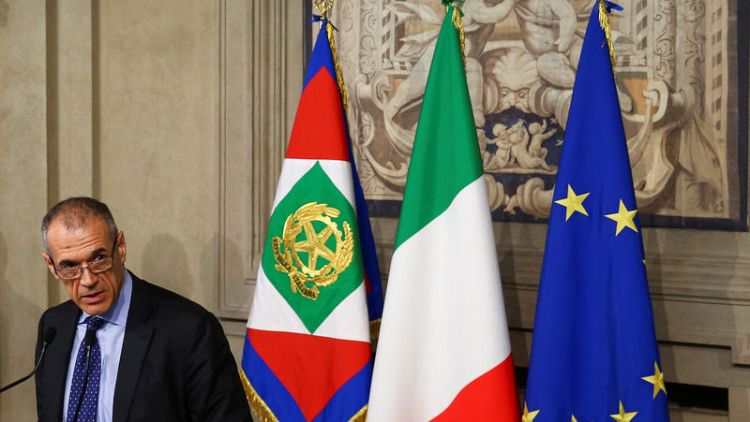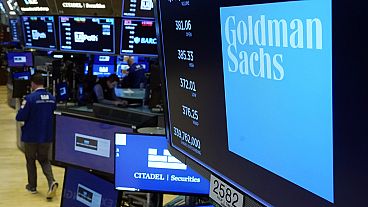By Marc Jones
LONDON (Reuters) - Investors are again speculating what the European Central Bank could do to solve the problem of a surge in Italy's debt yields that is causing stress for Italian banks and reviving questions about a euro break up.
The stakes will be huge if a repeat election in the euro zone's third-largest economy become a de facto referendum on Italy's membership of the euro and its role in the European Union.
Italy's economy is at least 10 times bigger than that of Greece, which needed 250 billion euros (217.7 billion pounds) of euro zone and IMF money to bail it out. If Italy needed a similar level of support, the numbers involved would be eyewatering.
Total International Monetary Fund firepower would only add up to around 500 billion euros and even with the 400 billion euros that the European Stability Mechanism could conceivably get together, it still wouldn't completely cover Italy.
Perhaps it's no wonder then that Italy's bond markets saw their worst sell-off in 26 years on Tuesday and investors are starting to look inquisitively at the ECB.
"If this continues for another couple of sessions, I think you will have to see some official (European) response," said Saxo Bank's head of foreign exchange strategy John Hardy.
"It becomes a 'whatever it takes' kind of moment," he added, recalling the promise made in 2012 by ECB President Mario Draghi to keep the euro intact.
Italian investors are equally anxious to see Frankfurt's response.
"If the situation doesn't calm down in the next 36 hours the ECB will have to weigh in some way," said Giuseppe Sersale, fund manager at Anthilia Capital Partners in Milan.
Pressure on the government yield curve could clog the central banks' money transmission mechanism and that alone would give the ECB cover to step in on monetary policy grounds, he said.
So what can the ECB do? After all it's almost impossible to imagine it would stand by and allow a domestic political crisis in Italy, Draghi's homeland, descend into another existential crisis for the euro zone.
It is still buying Italian debt as part of its 30 billion euro-a-month quantitative easing (QE) programme but it doesn't seem to have limited the damage.
Italy needs to refinance about 200 billion euros a year, analysts estimate, and the ECB's QE plan had been tipped to end in December.
That could be delayed of course, but it looks like it is the tool that evolved from the 2012 "whatever it takes" pledge - the yet-unused Outright Monetary Transactions (OMT) programme - that is being brandished again.
OMT's benefit is that it is technically unlimited and can be targeted directly at the heat in Rome.
The drawback though is that it would be politically toxic.
Italy's leading 5-Star Movement and the far-right League parties have shown a dislike for the euro, and in Germany there has long been concerns that use of OMT would be akin to propping up a government which goes well beyond its mandate.
"It raises a lot of issues again, but if we get into a situation where Italy starts to slipping into a crisis this is potentially a very big deal," said one European-based monetary official, who requested anonymity due to the issue's sensitivity.
"The size of the problem is bigger than anything we have had to deal with," he added.
READ THE RULES
Rules laid out by the ECB for OMT usage are strict and effective conditionality attached to an appropriate European Financial Stability Facility/European Stability Mechanism (EFSF/ESM) programme.
Such programmes can take the form of a full EFSF/ESM macroeconomic adjustment programme or a precautionary programme (Enhanced Conditions Credit Line), provided that they include the possibility of EFSF/ESM primary market purchases.
Such demands would take time and could cause fireworks in Italy. Much of 5-Star and League's political popularity has been built on a perception, among parts of the Italian population, that Rome has lost control of Italy's fate to Brussels.
"Italy knows the rules." Vitor Constancio, the ECB's soon-to-retire Vice President said in a Spiegel magazine on Tuesday about the conditionality for the ECB using its OMT tool. "They might want to read them again."
For nervous financial markets, it looks like another game of euro zone chicken where they wait to see who swerves first.
The risk of a euro break-up forced the ECB's hand six years ago and its OMT and the cheap LTRO funding programmes before that shows it can be creative when the politics gets ugly.
But the difference today is whether Italy wants that help or will instead choose scrap the euro or quit the European Union, or "Quitaly", which is a different proposition for the ECB and euro policymakers entirely.
Francesco Papadia, the former ECB head of market operations who helped construct the OMT plan thinks that unless there is a credible reassurance in Italy that an exit from the euro is out the question, markets won't calm down.
"The way the ECB could help is OMT, but the OMT requires a (ESM) programme and a programme requires a government and Italy does not have that."
Without that reassurance on Italy' future in the euro, the ECB would be trying to save "a country that doesn't want to be saved," Papadia said. "I would find it very difficult for the Governing Council to approve that."
(Additional reporting by Balazs Koranyi in Frankfurt; Editing by Edmund Blair)



